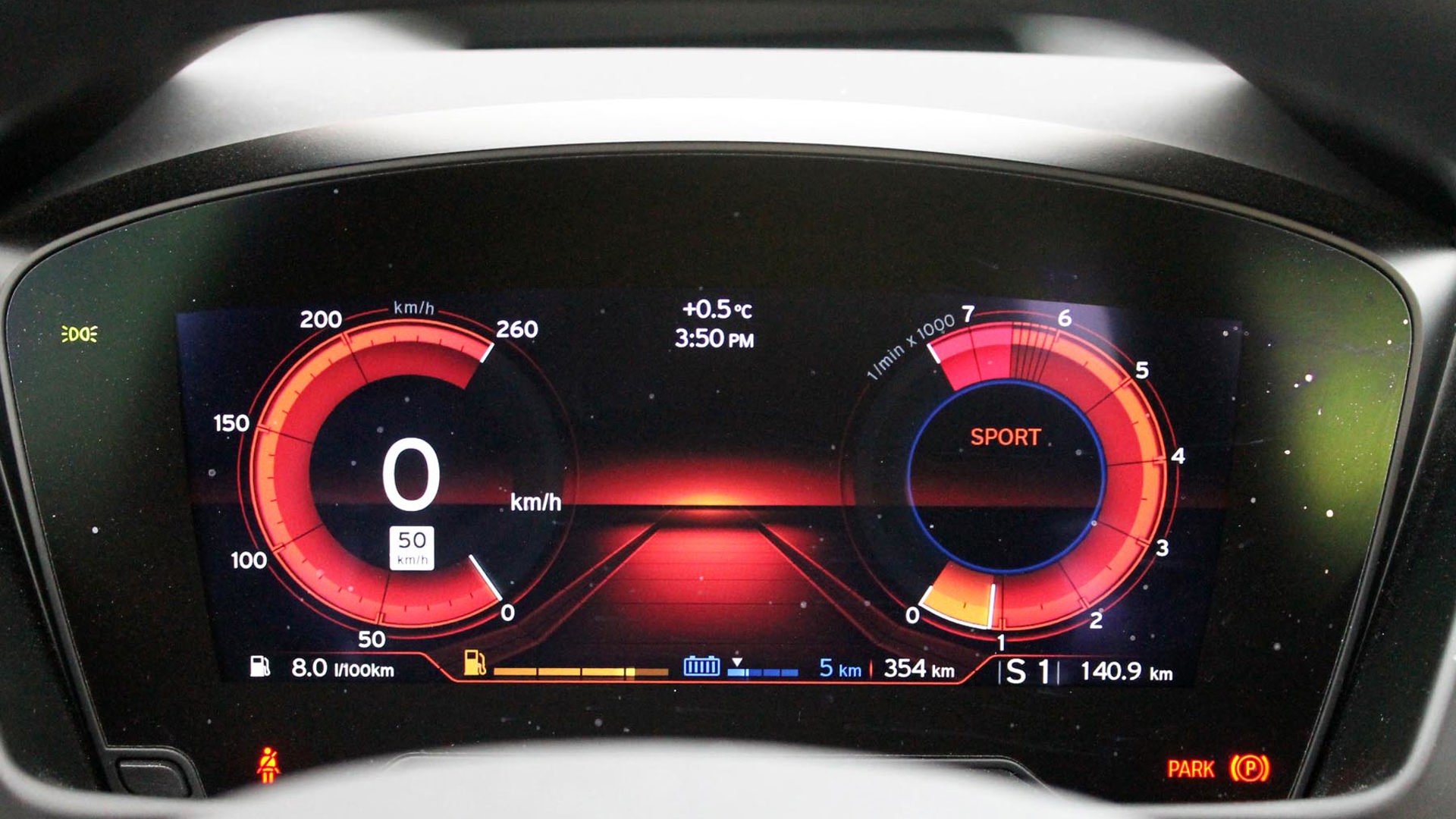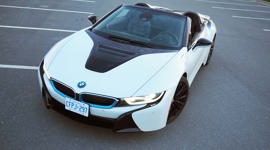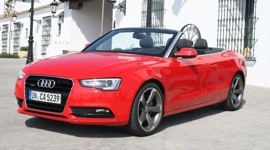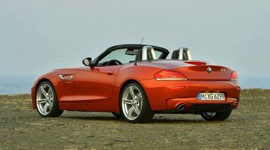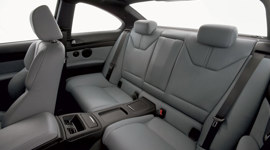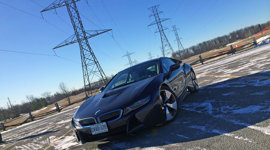If something should ever go wrong with your BMW i8, don’t even think about trying to fix it yourself. The hood doesn’t pop up easily to show off the electric motor, and the mid-mounted plastic shroud behind the rear seats does not come off quickly to expose the Mini-derived engine. Need to change a spark plug? Better book it in!
This is too bad, because I’m damned if I can figure out how BMW’s engineers managed to screw 228 horsepower and 236 lb-ft of torque out of the i3’s little 1.5L, three-cylinder engine. Those are the exact same figures Mini engineers are so proud of producing from the brand-new 2.0L, four-cylinder John Cooper Works edition. How did they find that power after chopping off a pot? I asked the BMW rep and he shrugged. “There’s always more to be found,” he offered, mysteriously.
If you want to be really clever, you can switch the car to EV mode and accelerate from zero-to-60 km/h in 4.5 seconds without using any gas at all.
BMW’s been looking for more since it began developing the i8, which is intended as a flagship for its new “i” brand of electric vehicles. The i8 is the flashy, expensive one, while the i3 is the flashy, compact one that’s more practical and a third of the price. There’ll be other i models coming down the pipe, maybe even an Mi8, though nothing’s yet confirmed. They’ll all be variations on a theme of electric propulsion and ultra-light weight, thanks to carbon-fibre body tubs and other clever stuff.
There are a handful of i8s in Canada now, sold since last fall, and the one I drove recently was equipped with Bridgestone Blizzak winter tires. This was curious, since the i8’s usual narrow tire is a carefully-developed blend of rubber that’s more about low rolling resistance than sporty traction. Blizzaks, however, are all about sticking to ice and frozen asphalt and care little for fuel consumption. I was happy, though: a storm dumped 10 centimetres of snow on the roads the first morning I walked out to the car.
A good deal of that 10 centimetres slid down onto the driver’s seat when I opened the clever aluminum door, which flipped up like a scissor door from its A-frame hinge, and then turned like a gull-wing to save height. Very fancy and very impressive, and everyone who saw them in operation cooed over the doors; everyone except me, who had to climb through the bloody things into the car. It’s not a graceful procedure, lifting one snowy boot over the sill while ducking down to slide through the low, narrow opening. You will hit your head several times, and when you do, there will be people watching.
But who really cares? You didn’t get an i8 to be subtle, or discreet. You got an i8 to tell people you’re a forward-thinking early adopter who cares about the environment, while also appreciating zero-to-100 km/h acceleration of 4.4 seconds. If you want to be really clever, you can switch the car to EV mode and accelerate from zero-to-60 km/h in 4.5 seconds without using any gas at all, except nobody will notice because the car will be pretty much silent, save for those Blizzaks slapping the asphalt. (When the engine’s running, the sound system pumps artificial growling noises through the door speakers to make it all more butch.) It’ll keep going all the way to 120 km/h on just the electric motor, too, whipping you down the highway with only the noise of the radio to show for it.
The i8 won’t do this for long, though. Its official battery range is just 37 km, and my own battery range, based upon my “enthusiastic” driving, was never greater than 18 km from a full charge. Not to worry – the i8 recharges itself on the fly. It only uses the electric motor when needed for extra boost. On a racetrack, driving 10/10ths, the battery will deplete pretty quickly but in normal driving, it takes much longer to run it down.
The gas engine is mounted over the rear axle and drives only the rear wheels, while the electric motor at the front drives the front wheels. This means the i8 is predominantly rear-wheel drive, but when you floor it, it becomes all-wheel drive and will zip confidently through traffic, even in 10 centimetres of snow. And because an electric motor develops maximum torque from standstill, there’s maximum torque for acceleration whenever you need it – no revving required. In fact, if you push it hard through the six gears of the automatic transmission, that electric motor keeps driving the front wheels while the rear is catching up between shifts, or coughing through its turbo lag.
This is the exact same principle applied to the other hybrid sports cars on the market: the Porsche 918, McLaren P1 and Ferrari LaFerrari, which cost many, many times more than the i8’s MSRP of $145,000.
Those cars also make a lot more power than the i8. That potent little turbocharged Mini engine has 25 psi of boost, and when you put it together with the 129 hp electric motor, which is itself governed by a two-speed automatic transmission, you get a total output of 357 hp and 420 lb-ft of torque. That’s quite something for a car that weighs less than 1,500 kg.
It’s not a match for the million-dollar McLaren P1, though, which makes more than 900 hp and weighs about the same. Or the 918, which also makes about 900 hp and is about 200 kg heavier. Or the LaFerrari, which is more powerful and lighter than both.
That’s okay. The i8 is clearly intended to be an everyday supercar, very comfortable inside with a premium feel and lots of space for two up front (and barely space for two more stubby-legged victims on the back seats). There’s a bit of room in the trunk for a briefcase. Its cabin has a layered design centered around the driver, with a Tron-like steering wheel and a central display screen that keeps things fairly simple.
The controller knob on the centre console that operates the display screen will be familiar to BMW owners, as will the console-mounted switch for toggling between Comfort, Sport and Eco Pro drive modes. That third setting scales back the performance and things like the air conditioning, and I can’t think why anyone would ever use it except to impress their tree-hugging partner. The Sport setting, however, changes the transmission to manual shifting – through either paddles or the central stick – and quickens the shifting and throttle response, tightens the steering and firms the suspension. More than that, it maximizes the power output from the electric motor and boosts the power regeneration when braking. The instrument gauges turn to fiery red to let you know you mean business, and a tachometer that turns counter-clockwise shares space beside the speedo.
There’s even another electric motor tucked away that powers the starter and, as such, is connected directly to the gas engine. If the main motor’s battery is completely depleted, this smaller motor will kick in if needed to give the i8 some extra squirt.
I spent much of my driving time in Sport, of course. The great pleasure of the i8 is its torque at all speeds: step on the gas at 80 km/h and you’ll be at 120 km/h in four seconds. That’s the official rating anyway, and it certainly felt like it out on the highway. There’s plenty of seat-of-the-pants driving feedback, though the electric steering is a little light in all three drive modes. The traffic knew who was boss and moved over respectfully, if only to let those other drivers snap better photos in profile with their cellphones as I passed.
I plugged the car in overnight a couple of times, although it only takes about three hours for an 80 percent recharge from a normal 110V power source. After 500 kilometres of driving, I pumped 40 litres of 94 Octane Premium into the gas tank, which corresponds to 8.0 L/100 km – a far cry from BMW’s official e-consumption estimate of 2.1 L/100 km. That testing was no doubt feathering the throttle and not driving far between charges, but nobody buys an i8 to save gas, whatever they tell their partners and friends.
So why does anyone buy a BMW i8? It’s not to tinker with it under a shade tree (does that even happen anymore, outside Cuba?). It’s not to save fuel, because you might as well get a Chevy Volt or even a Volkswagen Jetta. It’s not to race it on a track, or run with the big dogs.
This is why: It’s to drive a BMW and feel like you’re already a few years into the future, when every car will be lighter and more agile and more fuel-conscious. It’s to know that it was assembled in a German plant powered exclusively by wind turbines, and its carbon fibre was prepared in a Washington State plant powered cleanly by the local dam. It’s to make an impression beside the curb when the doors flip up and everybody – everybody – turns to watch. And more than anything else, it’s to drive through traffic and out on the highway with a powerful set of wheels beneath you, responsive to every thought at all highway speeds.
The fact you’re using no more fuel than a Toyota Corolla is also nice. Yeah, don’t forget to tell that to your mother.
| Warranty: 4 years/80,000 km; 4 years/80,000 km powertrain; 12 years/unlimited distance corrosion perforation; 4 years/unlimited distance 24-hour roadside assistance Competitors: |
| Model Tested | 2015 BMW i8 |
|---|---|
| Base Price | $145,000 |
| A/C Tax | $100 |
| Destination Fee | $2,095 |
| Price as Tested | $149,695 |
|
Optional Equipment
Carpo Interior World (LED Adaptive headlights, Carpo ivory interior) $2,500
|
|
















